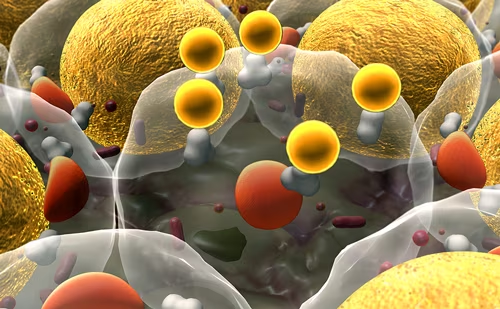Epigenetics, Gene Regulation, and Human Diseases
Epigenetics, Gene Regulation, and Human Diseases
Genes are not static and may be turned on or off, depending on what signals they receive from elsewhere in the body or from the surrounding environment. When they are turned on, genes express various proteins that, in turn, start a range of physiologic actions in the body. One way of affecting gene activity involves a process called DNA methylation, in which methyl groups, a cluster of carbon and hydrogen atoms, attach to certain nucleotides of a gene and make it easier or harder for that gene to receive and respond to messages from the body. In this way, the behavior of the gene is changed, but not the fundamental structure of the gene, or the DNA sequence, itself. This phenomenon is known as epigenetics and, remarkably, these DNA methylation patterns can be passed on to and inherited by new cells or even offspring.1 Epigenetic mechanisms are now implicated in gene regulation and the development of different diseases.2,3 What is fascinating about the epigenetic processes is that although mainly established early in life, it seems to be possible to affect it throughout life,4–7 suggestively through, for example, exercise, diet, and lifestyle.3
DNA Methylation in Human Adipose Tissue
The epigenome differs between cell types and has only been characterized for a limited number of human tissues. As obesity predicts type 2 diabetes, adipose tissue seems likely to also have a role in the disease development.8 Indeed, recent studies suggest adipose tissue DNA methylation to have a role in metabolic disturbances. For example, DNA methylation in the promoter of ADRB3 in visceral adipose tissue has been associated with waist-to-hip ratio and blood pressure in obese men.9 Also, the metabolic regulator PPARGC1A exhibit altered DNA methylation levels in subcutaneous adipose tissue after high-fat overfeeding in a birth weight dependent manner.10 This adds to the dynamic epigenetic regulation of this gene and the association with metabolic phenotypes, which has previously also been demonstrated in human skeletal muscle11,12 and pancreatic islets.13 PPARGC1A encodes the transcriptional co-activator peroxisome proliferator-activated receptor gamma (PPAR-g) coactivator-1a, which is known to regulate the expression of genes with a central role in mitochondria and it also plays a major role in adipose tissue.14–16 Another study identified 3,258 genes differentially methylated in visceral adipose tissue in obese individuals with or without the metabolic syndrome, translated into 41 pathways, pointing at structural components of the cell membrane, inflammation, and immunity, and cell cycle regulation to be important.17 The most comprehensive genome-wide DNA methylation study so far, considering adipose tissue, showed evidence of hypomethylated regions in tissue-specific regulatory elements that play a critical role in gene regulation and susceptibility to metabolic diseases.18 This was exemplified by an association of metabolic disease and altered DNA methylation in an enhancer element upstream of ADCY3, a region previously linked to metabolic diseases and processes. The strong tissue specificity of DNA methylation has also been shown within different adipose depots, with the ability to epigenetically regulate depot-specific gene expression in abdominal and gluteal adipose tissue.19 This is an important finding considering that different adipose depots are known to mediate different effects on the risk for metabolic disorders.
Multiple studies in human pancreatic islets as well as skeletal muscle suggest an epigenetic component in the regulation of genes involved in the pathogenesis of type 2 diabetes and glucose metabolism.5,6.20–23 However, the role of DNA methylation, and involvement of physical activity, on different genes in subcutaneous adipose tissue has until recently been poorly understood.
Genome-wide Changes in DNA Methylation in Response to Exercise
In a recent study, we investigated the genome-wide DNA methylation pattern in human adipose tissue biopsies before versus after a 6-month exercise intervention.24 The study cohort included middle aged, previously sedentary men. Surprisingly, we could see that changes in the DNA methylation pattern in adipose tissue had taken place on almost 18,000 individual CpG sites throughout the genome after the exercise intervention, corresponding to 7,663 unique genes or roughly 1/3 of all genes in the human genome. However, the absolute changes in DNA methylation were generally small, ranging from 0.2–10.9 % with a peak around 2–5 %. In most cases, the genes had become more methylated and about 90 % of the individual CpG sites that significantly changed in response to exercise increased the level of DNA methylation. Additionally, 1/3 of the gene regions with altered adipose tissue DNA methylation also showed a difference in the expression of that gene.
A similar approach has also been undertaken in human skeletal muscle using a different methodology.25 Here, 2,817 genes were found to be differentially methylated after the 6-month exercise intervention, but in contrast to what was found in adipose tissue, most of the genes showed decreased levels of DNA methylation after exercise. A pathway analysis revealed decreased DNA methylation of genes involved in retinol metabolism and calcium signaling as most significant after exercise. The insulin signaling pathway was enriched for genes exhibiting both increased and decreased DNA methylation.
Altered DNA Methylation of Genes Associated with Type 2 Diabetes and Obesity After Exercise Lifestyle interventions, including exercise and diet, are known to reduce the risk for type 2 diabetes in high-risk groups.26,27 One hypothesis in our study24 was therefore that altered adipose tissue DNA methylation as a result of physical activity could be one of the mechanisms of how selected candidate genes may affect the risk for metabolic diseases. Based on that, we investigated if candidate genes for obesity or type 2 diabetes, identified using genome-wide association studies,28 were found among the genes exhibiting changed levels of DNA methylation in adipose tissue in response to 6 months exercise. Among all 476,753 analyzed DNA methylation sites, 1,351 sites mapped to the 53 genes suggested to contribute to obesity, and 1,315 sites mapped to the 39 genes suggested to contribute to type 2 diabetes.
Indeed, we found 24 CpG sites located within 18 of the candidate genes for obesity with a significant difference in DNA methylation in adipose tissue in response to the exercise intervention (see Figure 1). Two of those genes (CPEB4 and SDCCAG8) also showed concurrent inverse change in messenger RNA (mRNA) expression after exercise. Among the type 2 diabetes candidate genes, 45 CpG sites in 21 different genes were differentially methylated in adipose tissue before versus after exercise (see Figure 1). Of note, 10 of these CpG sites mapped to KCNQ1, a gene known to undergo parental imprinting and encoding a potassium channel,29 and six CpG sites mapped to TCF7L2, the number one risk gene for type 2 diabetes. For both KCNQ1 and TCF7L2, all differentially methylated sites are found within the gene body, which is of particular interest since TCF7L2 encodes different splice variants30,31 and different methylation profiles between exons and introns may affect alternative splicing.32 Among the type 2 diabetes candidate genes with altered DNA methylation, a simultaneous change in mRNA expression was seen for HHEX, IGF2BP2, JAZF1 and TCF7L2, where mRNA expression decreased while DNA methylation increased in response to exercise.
Although the average difference in DNA methylation in response to exercise is of modest magnitude, the changes are often consistent across most individuals. This is, for example, seen for a methylation site in the gene body of ITPR2, where all individuals responded to exercise with an increase in DNA methylation. The ITPR2 locus has previously reported to be associated with waist–hip ratio.33 We found two methylation sites within this gene with altered DNA methylation in adipose tissue in response to exercise: one site located in the promoter region; one within the gene body. Interestingly, the men in the intervention also responded with a decrease in waist–hip ratio.
Also in skeletal muscle, exercise seems to affect the DNA methylation pattern of genes implicated in the pathogenesis of type 2 diabetes. For example, THADA and RBMS1 were differentially methylated in muscle in response to exercise in the study by Nitert et al.,25 as was MEF2A, a gene involved in the regulation of GLUT4 transcription.34 This study also investigated the impact of a genetic predisposition for type 2 diabeteson skeletal muscle DNA methylation and identified biological pathways including MAPK, insulin, and calcium signaling to be enriched for differentially methylated genes.25
Changes in DNA Methylation Induced by Exercise may Affect Adipocyte Metabolism Both HDAC4 and NCOR2 displayed increased DNA methylation and decreased mRNA expression in adipose tissue in response to exercise,24 and they are, for example, based on their capacity to regulate oxidative phosphorylation and GLUT4 expression, biologically interesting candidates in adipose tissue and the pathogenesis of obesity and type 2 diabetes.35,36 Furthermore, we found that HDAC4 had seven CpG sites within the gene body with an absolute difference in DNA methylation ranging from 5–8 % in response to exercise. Our functional studies where Hdac4 and Ncor2, respectively, were silenced in 3T3-L1 adipocytes resulted in 74 % reduction in the Hdac4 protein level and 56 % reduction in the Ncor2 mRNA level, accompanied by increased lipogenesis.24 These results suggest a link between DNA methylation, mRNA expression, and adipocyte metabolism, and could mean that regular exercise makes the adipocytes better in clearing the blood from glucose and lipids.
Conclusion
We recently described for the first time what happens on an epigenetic level in adipose tissue when we undertake physical activity and it is now evident that regular exercise can change the expression of our innate DNA through epigenetic mechanisms. The changes in DNA methylation in human adipose tissue in response to long-term exercise have a genome-wide range, but are also evident on the level of individual DNA methylation sites and genes. Interestingly, one-third of the differentially methylated CpG sites within gene regions also show a connection to altered gene expression of that gene.
Our results also suggest new mechanisms for how different genes may predispose to obesity or type 2 diabetes, and also a new mechanism for the beneficial effect of exercise on metabolic health. To account for cross-talk between tissues and the interplay within the whole human body, future studies should emphasize on investigating multiple tissues at different time points and in response to different external stimuli, to get a better understanding of the regulatory role of DNA methylation in the ever-changing environment. Additionally, it will be interesting to test if the epigenetic changes induced by exercise remain also when no or less exercise is performed, and if the epigenetic changes are reversible.







